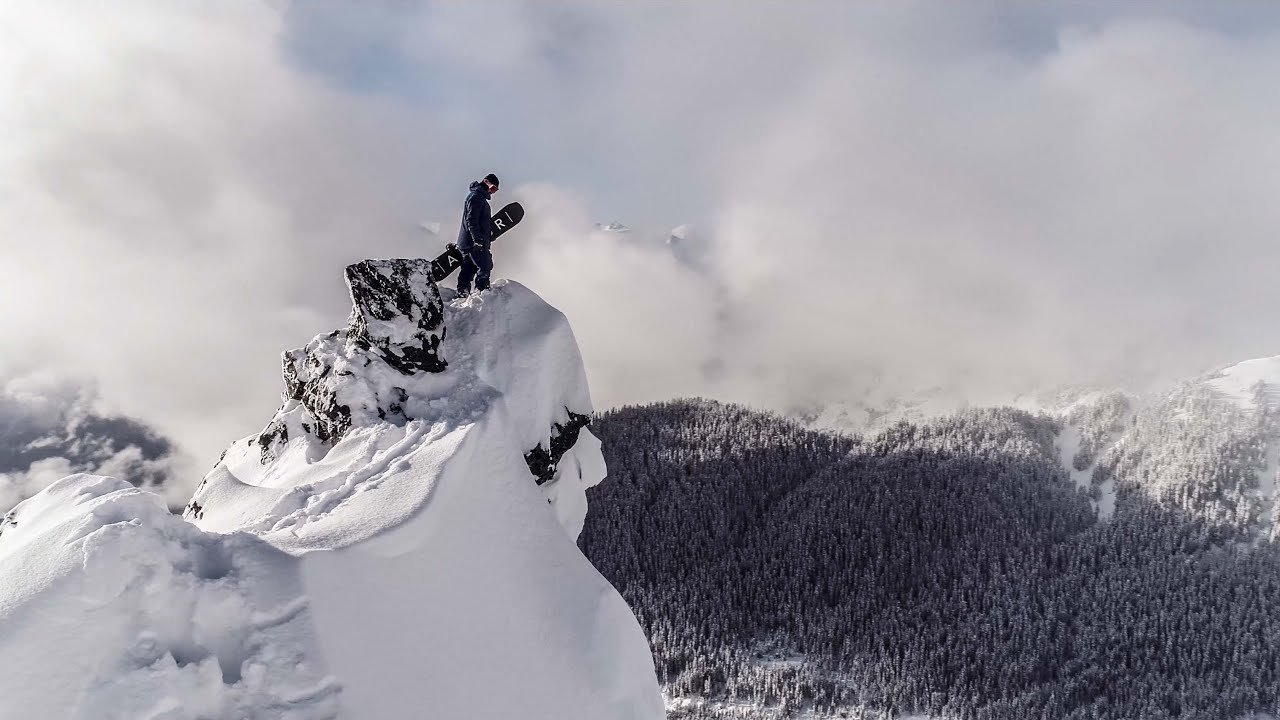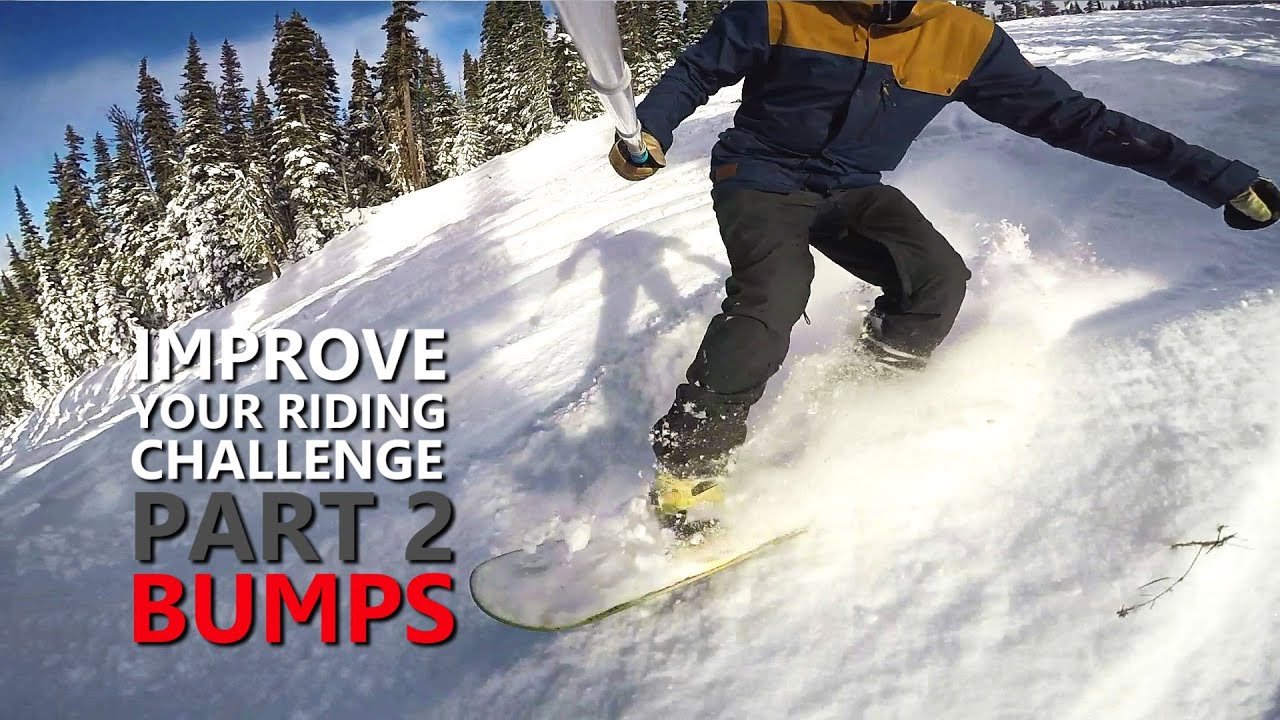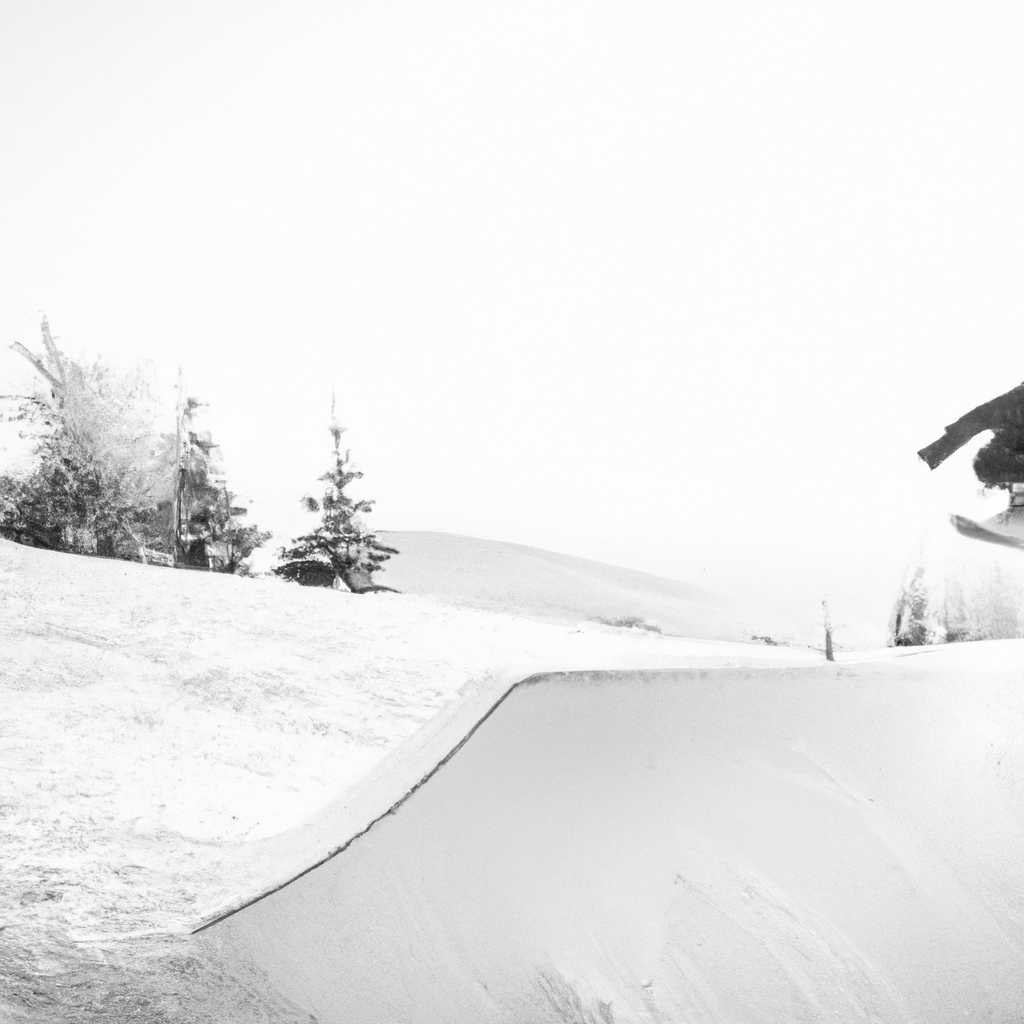
Improve Your Snowboarding Challenge | Part 2 – Bumps
Welcome back to another installment of SnowboardProCamp’s “Improve Your Snowboarding Challenge” series. In this second part, the focus is on riding over bumps to enhance your snowboarding skills. The video, hosted by SnowboardProCamp, highlights the importance of using your knees to absorb pressure and maintain control while snowboarding on uneven terrain. By bending your knees independently to absorb each bump and extending them between bumps, you can keep your snowboard in constant contact with the snow, allowing for better steering and speed control. Challenge yourself by finding a bumpy slope to practice these techniques and improve your riding. Enjoy the process and stay tuned for the next video in the series!
Hey there, guys! Today’s video is all about taking your riding skills to the next level. By challenging yourself to ride over bumpy and uneven terrain, you’ll be able to improve your snowboarding technique. Remember to utilize your knees to absorb any bumps and pressure that builds on your board. As you navigate each turn, the pressure on your board increases, and bending your knees will help to relieve that pressure. Don’t forget to extend your knees between the bumps to maintain constant contact between your snowboard and the snow. So go out there, find some uneven terrain and bumps, and have a blast improving your riding! If you have any questions, leave them in the comments. Thanks for watching and see you in the next video!
Understanding the Importance of Bumps in Snowboarding
Snowboarding over bumps is not only a thrilling experience but also a great way to improve your skills on the slopes. Bumps, also known as moguls, are raised mounds of snow that can be found on certain runs. While some snowboarders may try to avoid them, understanding the importance of bumps can greatly enhance your riding abilities. In this article, we will explore the significance of bumps in snowboarding and discuss how they can help you become a better rider.
Absorbing Pressure with Your Knees
One of the main benefits of riding bumps is that it teaches you how to properly absorb pressure with your knees. As you navigate through a mogul run, the uneven terrain creates extra pressure on your snowboard. By bending your knees, you effectively absorb this pressure, allowing for a smoother ride. The ability to absorb pressure with your knees is crucial in maintaining control and balance while snowboarding.
Maintaining Contact with the Snow
Another important aspect of riding bumps is the need to maintain constant contact with the snow. When you encounter a bump, your snowboard temporarily loses contact with the snow. However, by extending your knees between bumps, you can ensure that your snowboard remains in contact with the snow at all times. This constant contact provides stability and control, allowing you to navigate through the bumps more effectively.
Improving Balance and Control
Riding over bumps requires a high level of balance and control. As you traverse a mogul run, each bump presents a new challenge that requires you to adjust your weight distribution and body position. By regularly practicing on bumpy terrain, you can improve your balance and control skills. Over time, you will develop a better understanding of how to distribute your weight, making it easier to maintain stability and control in various snowboarding situations.
Challenging Yourself to Ride Uneven Terrain
Finally, riding bumps is an excellent way to challenge yourself and test your riding skills. Unlike groomed runs, mogul runs offer a more unpredictable and dynamic terrain. Navigating through bumps requires quick thinking, adaptability, and precision. By actively seeking out uneven terrain and bumps, you can push yourself to become a more versatile and confident snowboarder. Embracing this challenge will not only improve your riding abilities but also make your time on the slopes more exciting and rewarding.
Techniques for Riding Over Bumps
Mastering the techniques for riding over bumps is essential to smoothly navigate through moguls and make the most out of your snowboarding experience. In this section, we will discuss some key techniques that will help you ride over bumps with greater ease and control.
Bending Your Knees to Absorb the Bumps
To effectively ride over bumps, it is crucial to learn how to bend your knees to absorb the impact of each bump. As you approach a bump, bend your knees to compress your body and absorb the pressure. This action allows your snowboard to adapt to the changing terrain and reduces the impact felt on your legs and joints. By continuously flexing and extending your knees, you can maintain a smooth and controlled ride over the bumps.
Extending Your Knees Between Bumps
While bending your knees helps absorb the impact of each bump, it is equally important to extend your knees between bumps to maintain consistent contact with the snow. As your snowboard transitions from one bump to the next, extend your knees to raise your body and keep your snowboard in contact with the snow. This action ensures that you have better stability and control over your board, allowing for smoother turns and transitions.
Using Your Knees to Steer and Control Speed
In addition to absorbing bumps and maintaining contact with the snow, your knees play a crucial role in steering and controlling your speed while riding over bumps. By applying slight pressure through your knees and legs, you can initiate turns and adjust your direction as you navigate through moguls. Similarly, by releasing some of the pressure and extending your knees, you can increase your speed and glide over the bumps with ease. Developing this knee-controlled steering and speed control technique will greatly enhance your overall riding ability.
Practicing on Traversing Bumpy Runs
To improve your skills in riding over bumps, it is essential to practice on traversing bumpy runs. Look for runs that have a consistent line of bumps and traverse across them instead of going straight down the fall line. By traversing, you give yourself more time to react to each bump and focus on the proper technique of bending and extending your knees. Start with small, gentle bumps and gradually progress to larger and more challenging ones as you become more comfortable and confident. Regular practice on traversing bumpy runs will help you build muscle memory and improve your ability to ride over bumps effectively.

Finding the Right Terrain
To fully immerse yourself in the world of riding bumps, it is important to find the right terrain. In this section, we will discuss how to locate suitable slopes with bumps, assess the difficulty level of each run, choose varying levels of terrain, and evaluate safety factors.
Locating Slopes with Bumps
Finding slopes with bumps can be a bit of a treasure hunt, but with a keen eye and some research, you can locate the perfect mogul runs. Consider consulting trail maps or speaking with local snowboarders or mountain staff who can point you in the direction of runs known for their bumps. Additionally, pay attention to the terrain as you ride various slopes. If you come across a run with natural terrain features indicative of bumps, remember the location for future rides. Identifying and riding on slopes with bumps will provide you with the right playground to practice and refine your bump-riding skills.
Assessing the Difficulty Level
When seeking out terrain with bumps, it is essential to assess the difficulty level of each run. Bumps come in different sizes and shapes, with varying degrees of challenge. Before attempting a mogul run, take a moment to evaluate the overall difficulty and determine if it aligns with your current skill level. Starting with runs that have smaller, more spaced-out bumps can be a great way to gradually build your confidence and technique. As you progress, you can gradually move on to runs with larger and more tightly-packed bumps. Remember, it is important to challenge yourself, but always prioritize your safety and ride within your abilities.
Choosing Varying Levels of Terrain
To enhance your progression in bump riding, it is beneficial to choose varying levels of terrain. By exposing yourself to different types of bumps and terrain, you can broaden your skill set and become a more versatile snowboarder. The mountains offer a wide range of terrain, from gentle moguls to steep and challenging runs. As you explore different slopes and encounter varying levels of bumps, you will develop the ability to adapt and adjust your riding technique accordingly. Embracing different terrains will ultimately make you a more confident and capable rider.
Evaluating Safety Factors
Before attempting any new terrain, it is important to evaluate safety factors. Riding over bumps can introduce additional risks, especially if you are unfamiliar with the terrain or the current weather conditions. Factors such as visibility, snow conditions, and avalanche risks should always be taken into consideration. It is crucial to stay informed by checking weather forecasts and avalanche bulletins before heading out. Additionally, wearing proper protective gear, such as helmets and impact shorts, is essential to reduce the risk of injury.
Preparing Yourself for Riding Bumps
Before taking on the challenge of riding bumps, it is important to adequately prepare yourself physically and mentally. In this section, we will discuss some key steps to take in order to ensure a successful and enjoyable experience.
Warming Up and Stretching
Properly warming up your body and stretching before riding bumps is crucial to prevent injuries and improve performance. Engage in some light cardiovascular exercises, such as jogging or jumping jacks, to increase your heart rate and warm up your muscles. Follow this up with dynamic stretches that target the major muscle groups used in snowboarding, such as your quadriceps, hamstrings, and calves. Warming up and stretching will increase blood flow to your muscles, enhance flexibility, and decrease the risk of strains and sprains.
Ensuring Proper Equipment Fit
Having properly fitting equipment is essential for a comfortable and effective riding experience. Before hitting the slopes, check that your snowboard boots are snug and secure, providing adequate support for your feet and ankles. Your bindings should be adjusted so that your boots are securely fastened, with no excessive movement. Additionally, ensure that your snowboard is appropriate for the terrain and your riding style. Investing in quality gear that fits well will not only improve your performance on bumps but also enhance your overall comfort and safety while snowboarding.
Reviewing Basic Riding Techniques
Riding bumps requires a solid foundation of basic riding techniques. Before heading to a mogul run, take some time to review and practice fundamental skills such as turning, carving, and stopping. Having a strong grasp of these techniques will provide you with a solid base to build upon as you navigate through bumps. If needed, consider taking a lesson or seeking guidance from experienced instructors who can help refine your skills and provide valuable tips specific to riding over bumps.
Building Confidence and Mental Focus
Confidence and mental focus are key when it comes to successfully riding over bumps. It is important to approach each descent with a positive mindset and believe in your abilities. Visualize yourself smoothly navigating through the bumps and focus on maintaining a relaxed and balanced stance. Practicing mindfulness techniques, such as deep breathing and visualization, can also help calm your mind and enhance your focus. Building confidence and mental focus will ultimately improve your performance and allow you to fully enjoy the thrill of riding over bumps.

Developing Proper Techniques
To excel in riding bumps, it is crucial to develop and master proper techniques. In this section, we will discuss some key techniques that will help you maintain control and stability while riding over bumps.
Maintaining a Low and Balanced Stance
When riding over bumps, it is important to maintain a low and balanced stance. Keep your knees slightly bent and your weight centered over your snowboard. This low stance allows for greater flexibility and absorbs the impact of each bump more effectively. By staying balanced and centered, you will have better control over your board, making it easier to navigate through the bumps.
Flexing and Extending Your Ankles
In addition to bending your knees, flexing and extending your ankles can greatly improve your riding technique on bumps. As you approach a bump, flex your ankles to bring your weight slightly forward, preparing for the impact. When you reach the peak of the bump, extend your ankles to shift your weight back and maintain contact with the snow. This ankle movement, in combination with knee bending and extending, allows for better absorption of each bump and improves your overall stability.
Keeping Your Core Engaged
Engaging your core muscles is essential for maintaining stability and control while riding over bumps. Keep your abdominal muscles activated and your core engaged throughout the ride. This will provide you with a solid center of gravity and enhance your ability to adapt to the constantly changing terrain. A strong core will also help alleviate strain on your back and prevent unnecessary fatigue.
Utilizing Upper Body Movement
While the focus is often on the lower body, utilizing upper body movement can significantly improve your riding technique on bumps. As you navigate through the bumps, allow your upper body to move and rotate naturally in response to the terrain. This slight upper body movement helps maintain balance and counterbalances the movements of your lower body. By incorporating upper body movement into your riding technique, you can achieve a more fluid and controlled ride over bumps.
Applying Technique in Different Riding Situations
To fully embrace the challenge of riding bumps, it is important to apply your technique in different riding situations. In this section, we will explore how to navigate through groomed runs, master powder and off-piste riding, tackle moguls and steep terrains, and adjust to different speeds and conditions.
Navigating Through Groomed Runs
Even though groomed runs may not have as many bumps as mogul runs, it is still important to apply your bump-riding techniques. Keep a low and balanced stance, bend your knees to absorb any smaller bumps on the groomed surface, and use your knees and ankle movement to maintain control and stability. Practice navigating through groomed runs using the techniques you have developed on bumps. This will allow you to consistently execute proper technique and further enhance your overall riding ability.
Mastering Powder and Off-Piste Riding
Powder and off-piste riding present their own unique challenges when it comes to riding bumps. The soft, deep snow can make it more difficult to maintain stability and control, especially when encountering bumps underneath the surface. When riding in powder, adapt your technique by using wider turns and keeping a more centered stance. Allow your snowboard to float on top of the snow as you bend and extend your knees to absorb the hidden bumps. Mastering powder and off-piste riding in combination with your bump-riding skills will make you a well-rounded snowboarder.
Tackling Moguls and Steep Terrains
Tackling moguls and steep terrains requires a higher level of skill and technique. Apply your bump-riding techniques as you encounter moguls, focusing on bending your knees to absorb each bump and extending between bumps to maintain contact with the snow. It is also important to adapt your line and choose the best route through the moguls. When riding steep terrains, adjust your stance to a more aggressive position, with your weight slightly forward. Keep your turns shorter and sharper, allowing you to maintain control and navigate through the bumps effectively.
Adjusting to Different Speeds and Conditions
As a snowboarder, you will inevitably encounter different speeds and conditions on the mountain. Adjusting your technique accordingly is crucial to maintain control and ride safely. In high-speed situations, focus on maintaining a strong and stable position, spreading your weight evenly over your board. This will minimize the effects of bumps and allow you to maintain control at higher speeds. In icy or firm conditions, adapt your technique by using more precise and deliberate movements when encountering bumps. Adjusting your technique to match the speed and conditions will help you stay in control and ride with confidence in any situation.
Safety Tips for Snowboarding on Bumps
Safety should always be a top priority when it comes to snowboarding, especially when riding on bumps. Here are some important safety tips to keep in mind:
Wearing Proper Protective Gear
Before hitting the slopes, ensure that you are wearing proper protective gear. This includes a helmet, goggles, wrist guards, and impact shorts. Wearing a helmet can greatly reduce the risk of head injuries in the event of a fall or collision. Goggles protect your eyes from sun, wind, and snow, providing clear vision on the slopes. Wrist guards help prevent wrist injuries, which are common in snowboarding. Impact shorts offer additional protection to your hips and tailbone, cushioning any falls or impacts. Investing in and consistently wearing proper protective gear is essential for your safety while riding bumps.
Assessing the Terrain and Weather
Always assess the terrain and current weather conditions before riding bumps. Take note of any potential hazards, such as rocks, tree stumps, or other obstacles that may be hidden in the bumps. Look for signs of recent avalanches or unstable snow conditions, and avoid riding in areas with a high risk of avalanche. Additionally, pay attention to visibility and how the weather may affect the snow conditions. Poor visibility can make it more challenging to navigate through bumps safely. By staying aware of the terrain and weather, you can make informed decisions and prioritize your safety while riding bumps.
Avoiding Hazardous Areas
Certain areas on the mountain may be more hazardous due to the presence of cliffs, deep tree wells, or thin snow coverage. Avoid riding in these hazardous areas, especially when tackling difficult bump runs. If you are uncertain about the safety of a particular area, it is best to seek advice from mountain staff or experienced riders. Remember, the goal is to have a challenging and enjoyable experience while minimizing risks to yourself and others.
Riding with a Buddy
Whenever possible, ride with a buddy, especially when attempting challenging terrain like bump runs. Having a riding partner provides an extra level of safety and allows for immediate assistance in case of an accident or injury. Communication is key when riding with a buddy, ensuring that both of you are aware of each other’s intentions and riding style. Furthermore, it is always advisable to inform someone off the mountain about your plans and expected return time. Riding with a buddy is not only safer but can also enhance the overall enjoyment of your snowboarding experience.
Common Mistakes to Avoid
While riding bumps can be exciting and rewarding, there are some common mistakes that riders should avoid to ensure a smooth and enjoyable experience. By being aware of these mistakes, you can save yourself valuable time and effort in your progression as a bump rider.
Riding with Stiff and Locked Knees
One of the biggest mistakes riders make when encountering bumps is riding with stiff and locked knees. Stiff knees do not allow for effective absorption of the bumps and can lead to loss of control and balance. Instead, focus on keeping your knees slightly bent and flexible at all times. This will allow for better absorption of each bump and help maintain stability and control throughout your ride.
Losing Balance and Control
Maintaining balance and control is crucial when riding over bumps. It is not uncommon for riders to lose balance and control, especially when encountering larger or unexpected bumps. To avoid this, always keep your weight centered over your snowboard and maintain a low, balanced stance. Practice maintaining balance and control on groomed runs before progressing to more challenging terrain. By continuously working on your balance and control, you will be better prepared to handle any bumps that come your way.
Neglecting Weight Distribution
Neglecting proper weight distribution is another common mistake made by bump riders. Your weight should be evenly distributed over your snowboard, allowing for better control and maneuverability. Avoid placing too much weight on your front foot or back foot, as this can lead to imbalances and loss of control. Practice shifting your weight smoothly and intentionally from one foot to another as you navigate through the bumps. This will allow for better stability and more efficient turns.
Neglecting to Use Upper Body
The upper body plays an important role in maintaining balance and control while riding bumps. Neglecting to use your upper body can lead to unnecessary strain on your lower body and compromised stability. Allow your upper body to move naturally in response to the terrain, counterbalancing the movements of your lower body. By incorporating upper body movement, you will achieve a more fluid and controlled ride over bumps.
Practicing and Progressing
Practicing regularly and progressing at your own pace is key to mastering the art of riding bumps. In this section, we will discuss some strategies to help you practice effectively and track your progress.
Starting with Beginner-friendly Bumps
If you are new to riding bumps, it is important to start with beginner-friendly bumps. Look for runs with smaller and more spaced-out bumps to build your confidence and technique. As you become more comfortable, gradually progress to runs with larger and more tightly-packed bumps. Starting with beginner-friendly bumps allows you to practice proper technique and develop the necessary skills without feeling overwhelmed. Remember, the journey to becoming a proficient bump rider is a gradual process, so be patient and enjoy the ride.
Gradually Increasing the Difficulty
As you gain confidence and proficiency in riding bumps, it is crucial to gradually increase the difficulty level. Seek out runs with more challenging bumps or explore different mogul fields on the mountain. By gradually increasing the difficulty, you will continue to challenge yourself while building on the skills you have already developed. Pushing your limits in a controlled and progressive manner will help you grow as a rider and keep your snowboarding experience exciting and fulfilling.
Using Video Analysis and Feedback
Using video analysis and seeking feedback from experienced riders can greatly enhance your progress in riding bumps. Film yourself while riding over bumps and review the footage to identify areas for improvement. Pay attention to your body position, weight distribution, and overall technique. Seek input from experienced riders or instructors who can provide valuable insights and tips specific to riding bumps. This external feedback, combined with self-reflection, will help you understand your strengths and weaknesses and refine your technique accordingly.
Setting Realistic Goals and Tracking Progress
Setting realistic goals and tracking your progress is crucial for continuous improvement. Establish specific objectives for each riding session, whether it be improving your technique on a particular aspect of bump riding or conquering a more challenging line. Keep a record of your achievements and take note of areas where you need further development. Celebrate your successes along the way, no matter how small, as these milestones will keep you motivated and inspired to push further. By setting goals and tracking progress, you will be able to measure your growth and establish a foundation for future success.
Conclusion
Riding bumps can be an exhilarating and rewarding experience for snowboarders of all skill levels. By understanding the importance of bumps, mastering the necessary techniques, and utilizing proper safety measures, you can take your riding to new heights. Remember to always assess the terrain, wear appropriate protective gear, and progressively challenge yourself. With practice, perseverance, and a commitment to continual improvement, you will become a more confident and skilled bump rider. Embrace the bumps, enjoy the journey, and have fun exploring the world of snowboarding!
